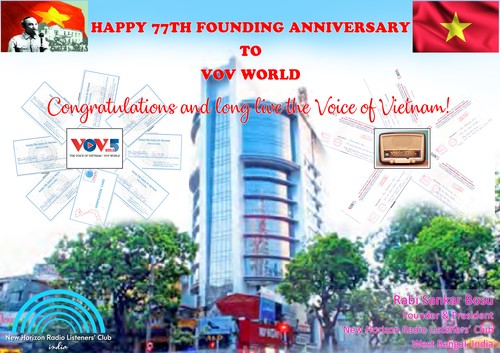 A e-postcard from Rabi Sankar Bosu, Founder and President of New Horizon Radio Listeners' Club, West Bengal, India A e-postcard from Rabi Sankar Bosu, Founder and President of New Horizon Radio Listeners' Club, West Bengal, India |
B: Bidhan Chandra Sanyal of India wrote: “On the 77th anniversary of the establishment of Voice of Vietnam, sincere congratulations to all the officials, artists, and journalists of Voice of Vietnam. Voice of Vietnam evokes in listeners a sense of ethics, elegant taste, thoughtfulness, mental excellence, and above all, ideals of a fulfilling life. Wishing Voice of Vietnam all the best!”
A: Amir Jameel of Pakistan said: “Congratulations and best wishes on 77 Golden Years of Voice of Vietnam, September 7, 1945-2022. On this very important occasion, we extend our heartiest congratulations and greetings to the old and new staff and management of Voice of Vietnam. Because of their tireless efforts, Voice of Vietnam is now one of the leading radio stations in the world.”
B: Once again, many thanks to you all for accompanying VOV over the years!
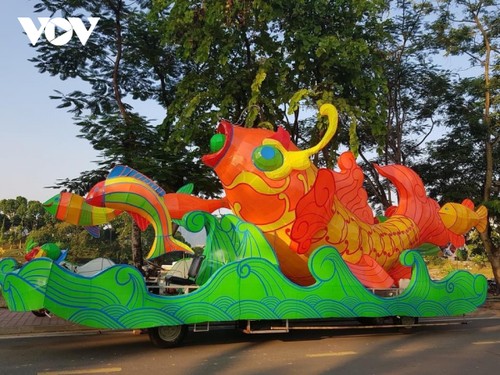 Tuyen Quang province organizes a parade of huge lanterns to celebrate the Mid-Autumn Festival. (Photo: VOV) Tuyen Quang province organizes a parade of huge lanterns to celebrate the Mid-Autumn Festival. (Photo: VOV) |
A: From China, Ding Lu emailed us to say that he received VOV’s English language program on August 26 on the frequency of 9840KHz. The signal was very strong but the reception was not very clear, he said.
B: Thank you, Lu, for your technical remarks, which our technicians use to monitor VOV’s overseas broadcasts.
A: Lu told us: “The traditional Mid-Autumn Festival is coming. I wish the Voice of Vietnam’s English service and all good friends a happy Mid-Autumn Festival! It’s an occasion for family reunions. I don't know how Vietnamese friends spend the Mid-Autumn Festival! Is it the same as China? Do you eat moon cakes and enjoy the moon?”
B: Thanks for the interesting question. The Mid-Autumn Festival in Vietnam takes place on the full moon night of the 8th lunar month, involving the custom of moon contemplation and procession of lanterns. Moon cakes – sticky rice cakes and other baked cakes – are iconic cakes of the Full-moon Festival.
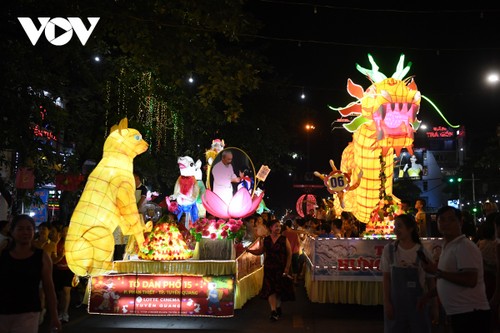 Tuyen Quang province organizes a parade of huge lanterns to celebrate the Mid-Autumn Festival. (Photo: VOV) Tuyen Quang province organizes a parade of huge lanterns to celebrate the Mid-Autumn Festival. (Photo: VOV) |
A: Vietnam has many legends that explain the phases of the moon and the dark, mysterious images we can see from the earth. Modern science tells us that on the full-moon day the moon’s orbit is at its lowest angle to the horizon, making the moon appear brighter and larger than at any other time of the year.
B: Little children believe a fairy tale that says the dark shapes on the moon are a banyan tree, a buffalo boy, a fairy, and her rabbit.
A: During the Full-moon Festival children parade in the streets, singing and carrying colorful lanterns in the shape of moons, stars, fishes, rabbits, and butterflies, which spin when candles are inserted.
B: One important feature of Vietnam’s Mid-Autumn Festival is lion dancing. Both amateur and professional groups perform dances on stages, on the streets, and at people’s houses.
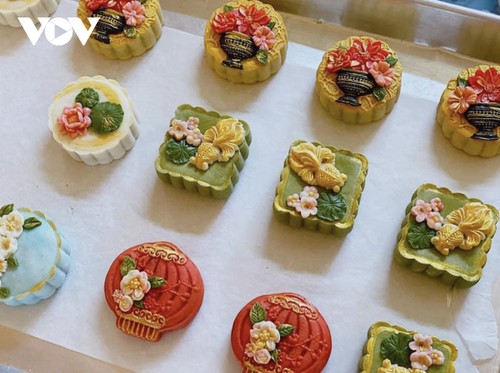 New designs of Mid-Autumn cakes (photo: internet) New designs of Mid-Autumn cakes (photo: internet) |
A: Giving and enjoying moon-cakes is another Mid-Autumn tradition. The traditional recipe calls for lotus seeds, green bean paste, and orange peels, and a bright egg yoke in the center to represent the moon. Now bakers often add red beans, taro, grilled pork, and whatever else they can think of.
B: There are two typical moon cakes in Vietnam. “Banh deo” is a white cake made of sticky rice and filled with sweet a mixture of lotus seeds, and pumpkin seeds, and green bean paste. “Banh nuong” is a brown cake with a similar taste to banh deo. Both can be either square or round shapes, symbolizing the earth and the sky.
A: The Full-moon Festival caters to children. Many social organizations and agencies organize entertainment for children, especially this year, after 2 years of social distancing due to COVID-19.
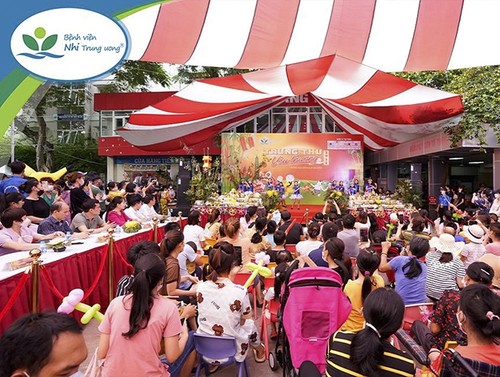 The National Children's Hospital organizes an early Mid-Autumn Festival for children being treated there. (photo: benhviennhitrunguong.org.vn) The National Children's Hospital organizes an early Mid-Autumn Festival for children being treated there. (photo: benhviennhitrunguong.org.vn) |
B: The National Children's Hospital is organizing an early Mid-Autumn Festival for 2,000 children being treated there, who are unable to celebrate the Festival at home.
A: There are art performances, games with prizes, and 30 booths where the children can receive gifts, take photos, and make cakes, lanterns, and To he pastry miniature figurines. In the hospital yard are electric cars, fishing with magnets, statue painting, and sand paintings.
B: Trinh Ngoc Hai, Deputy Director of the National Children's Hospital, said: “We are visiting patient rooms to deliver gifts to children who are gravely ill and cannot walk. We want to comfort them and their families and raise their spirits so their treatment will be more effective.”
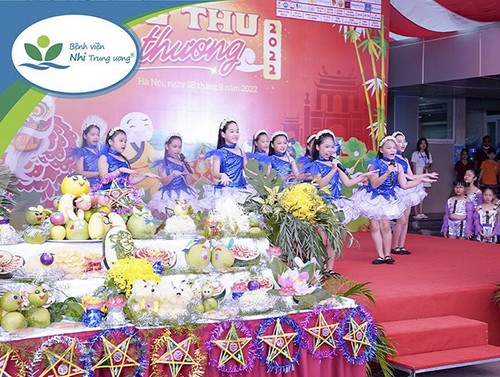 The National Children's Hospital organizes an early Mid-Autumn Festival for children being treated there. (photo: benhviennhitrunguong.org.vn) The National Children's Hospital organizes an early Mid-Autumn Festival for children being treated there. (photo: benhviennhitrunguong.org.vn) |
A: The National Children's Hospital has raised donations to provide free meals, clothes, medicine, and surgery to children from poor families.
B: Takahashi Ishiguro of Japan wrote to us this week that he’s interested in Vietnam’s traditional musical instruments, particularly bamboo flutes.
A: Well, the Vietnamese bamboo flute has long been one of the most popular wind instruments. The moody sound it produces captures the emotional life of the Vietnamese people. The bamboo flute remains an important musical instrument, solo or accompanying other instruments in traditional as well as modern Vietnamese music.
B: The Vietnamese bamboo flute is particularly popular in the countryside because it’s easily made from materials abundant in rural Vietnam. Images of little boys blowing flutes while herding buffalos or flying kites are iconic of the Vietnamese countryside.
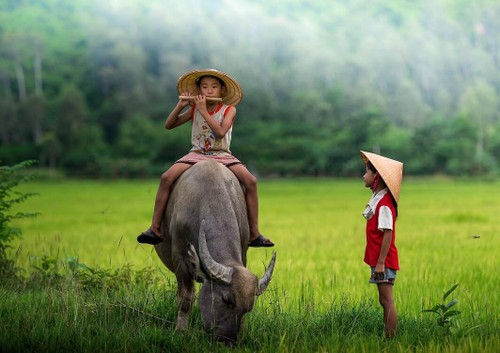 A buffalo boy blowing flute is a typical image of Vietnam's countryside. A buffalo boy blowing flute is a typical image of Vietnam's countryside. |
A: The Vietnamese bamboo flute is usually made from a single piece of bamboo, 40 to 55 centimeters long and 1.5 to 2 cm in diameter. The flute’s thickness is a key element determining its timbre or ‘tone color”. Flutes with thick walls have a darker sound, because it requires more force to make the bamboo vibrate. Thin-walled flutes produce a brighter sound.
B: The bamboo flute is an essential instruments in Cheo (popular theater), Cai Luong (reformed theater), and Chau Van (ritual singing). The drum, the bamboo flute, and the two-chord fiddle are the three essential instruments in a Vietnamese orchestra.
A: That concludes today’s program. We welcome your feedback at: English Service, VOVWorld, the Voice of Vietnam, 45 Ba Trieu street, Hanoi, Vietnam. Or you can email us at: englishsection@vov.vn. You’re invited to visit us online at vovworld.vn, where you can hear both live and recorded programs.
B: Check out our VOV Media App, available on both the IOS and Android platforms, to hear our live broadcasts. We look forward to your feedback on the mobile version of vovworld.vn. Once again, thank you all for listening. Goodbye.